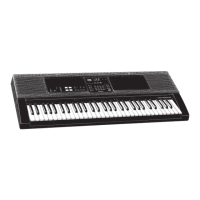
Do you have a question about the Casio CTK-650 and is the answer not in the manual?
| Brand | Casio |
|---|---|
| Model | CTK-650 |
| Category | Electronic Keyboard |
| Language | English |
Diagram and list identifying all buttons, controls, and their numerical assignments on the keyboard.
Highlights 128 tones, Layer and Split keyboard capabilities for playing two tones simultaneously.
Explains Magical Presets for varied play and Sound/Control pads for percussion or subtle tone control.
Covers enhanced auto-accompaniment and Song Memory for practice or listening.
Details powering the keyboard via batteries, AC adapter, or car cigarette lighter, including installation.
Essential precautions for battery usage to prevent damage or leakage, and symptoms of low power.
Instructions on switching the keyboard power on and off, and adjusting the volume.
Guide to selecting from 128 available tones using the console and 10-key pad.
Explains Touch Response for matching note power to key pressure and how to switch it on/off.
Details on how to play and navigate the three built-in demo tunes for practice or enjoyment.
Instructions on selecting and applying one of ten available digital effects to enhance sound.
Guide to choosing from 128 built-in rhythm patterns and adjusting tempo.
Explains auto-accompaniment, chord modes (CASIO CHORD, FINGERED), and synchro start.
How to assign two different tones to different locations on the keyboard.
Instructions for playing two different tones simultaneously by pressing a single key.
How to use Split and Layer together for different layering at the low and high ends of the keyboard.
Procedure to change the set of functions assigned to the sound/control pads.
How to select and apply one of the 128 built-in Magical Presets for special effects.
How to store and recall keyboard setups (tones, rhythms, effects) using registration memory.
Details on recording, playing back, and managing data within the Song Memory.
Introduction to MIDI, its capabilities for sending/receiving data, and MIDI terminals.
Setting the basic MIDI channel and understanding channel allocation for various functions.
Managing General MIDI compatibility and local control settings for MIDI communication.
Adjusting pitch bend range and controlling accompaniment data output via MIDI.
Instructions on how to tune the keyboard and transpose its key for playing.
Adjusting the keyboard's response to playing pressure for different sound outputs.
A table detailing problems, their possible causes, and recommended actions for keyboard operation.
Guidelines for keyboard maintenance and a summary of technical specifications.
